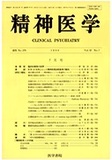Japanese
English
- 有料閲覧
- Abstract 文献概要
- 1ページ目 Look Inside
抄録 覚醒剤精神病の精神生理学的特徴を検討するため,22例の覚醒剤精神病患者を対象に聴覚刺激により事象関連電位(Event-related Potentials)を記録,精神分裂病患者,健常者の所見と比較した。この結果,①反応時間は分裂病患者において健常者より延長していたが,覚醒剤精神病患者と健常者の間に差はなかった。②P300の潜時は患者群で延長していた。③P300の振幅は分裂病患者において健常者より減衰し,覚醒剤精神病患者に比べ減衰する傾向を示した。また覚醒剤精神病患者は健常者に比べ減衰する傾向を示した。④P300の面積は分裂病患者と健常者の間に差がみられたが,覚醒剤精神病患者と健常者の間に差はなかった。以上から覚醒剤精神病は精神分裂病ほど深い認知の障害を示さないことが示唆され,またこの結果は両疾患の鑑別点として指摘されている対人的態度や現実検討能力の相違を反映していると推測した。
Auditory event-related potentials (ERPs) were recorded during oddball paradigm in 22 methamphetamine psychotic patients. ERPs in these patients were compared to those of age-matched normal controls and schizophrenic patients. Three components of P 300 were measured by means of latency, amplitude and area. The following results were obtained. (1) Schizophrenic patients showed longer reaction time than normal controls, but methamphetamine psychotic patients did not. (2) Methamphetamine psychotic patients and schizophrenic patients showed significantly longer P 300 latency than normal controls. (3) Although schizophrenic patients showed significantly smaller P 300 amplitude and area than normal controls, methamphetamine psychotic patients did not. These findings suggest that methamphetamine psychotic patients have less congnitive deficits than schizophrenic patients.

Copyright © 1990, Igaku-Shoin Ltd. All rights reserved.


